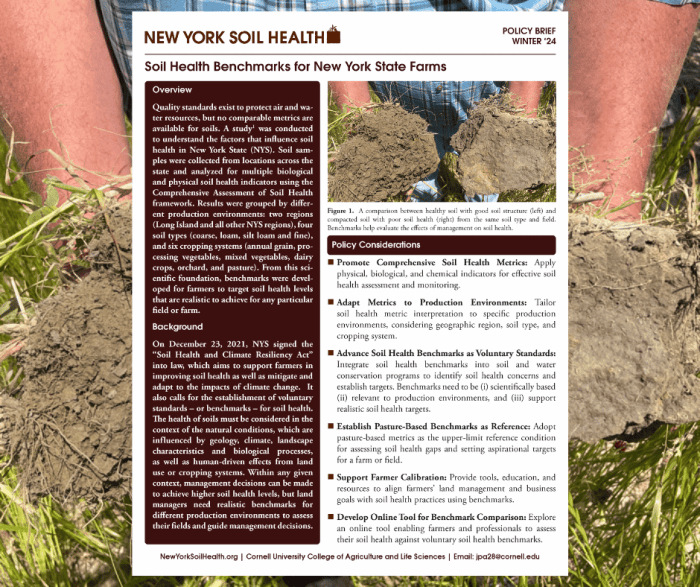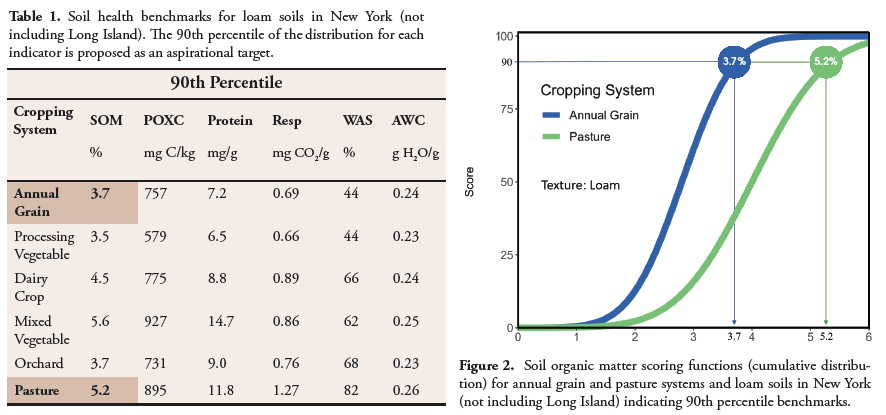
By Kitty Gifford
Watch the webinar recording here and contribute to the public comment period now open
As the agricultural community seeks to enhance soil health in response to the Soil Health and Climate Resiliency Act, the New York Soil Health initiative presents its latest policy brief, “Soil Health Benchmarks for New York State Farms.” The brief introduces policy considerations for voluntary soil health metrics, providing benchmarks reflective of the state’s diverse agricultural landscape.
The Soil Health and Climate Resiliency Act (Senate: S4722A/House: A5386A), signed into law in 2021 by Gov. Kathy Hochul, and supported by Cornell research and the state’s farmers, calls for establishing “appropriate voluntary standards and objectives for soil health…reflective of different geographic regions, soil types, and farming operations.”
The policy brief insights stem from a detailed study that collected soil samples across New York. Cornell University researchers used the Comprehensive Assessment of Soil Health analysis at the Cornell Soil Health Laboratory to assess multiple biological and physical indicators. The results were categorized based on two regions (Long Island and all other NYS regions), four soil types, and six cropping systems. The resulting framework of Production Environment Soil Health (PESH) benchmarks was used to establish aspirational targets for farmers.
These benchmarks assist farmers in setting realistic soil health targets, considering factors like climate, soil type, and cropping system.
Researchers with New York Soil Health set the voluntary soil health benchmarks at the 90th percentile of each production environment. These represent soil health levels achieved by the top 10 percent of fields within each production environment. Farmers can use these benchmarks to assess their field’s soil health relative to peers, with the 90th percentile proposed as aspirational targets within specific production environments.

Soil health benchmarks for loam soils in New York (not including Long Island). The 90th percentile of the distribution for each indicator is proposed as an aspirational target. See complete benchmarks here.
The policy brief highlights a holistic approach to soil health, promoting comprehensive metrics and adapting them to specific production environments. It emphasizes the importance of voluntary soil health benchmarks, scientifically based and relevant to diverse production settings. Pasture-based benchmarks are proposed as upper-limit references, offering aspirational targets for assessing soil health gaps.
Accessing the Policy Brief and Soil Health Benchmarks
The policy brief is available here. The complete benchmarks, can be accessed through an open-access publication and the New York Soil Health website.
Have Your Say
Comment on the Production Environment Soil Health Benchmark concept and science. Please share your perspectives on the benchmarks as well as suggestions on how to integrate voluntary standards in response to legislation by March 31, 2024.
Join the Webinar
Save the date for March 6, 2024, from noon to 1 pm. Delve deeper into the study and policy brief. Joseph Amsili, Debbie Aller, and Harold van Es will guide the discussion in “Benchmarking Soil Health for Production Environments.”
Webinar recording available here:
https://youtu.be/mqc7C7NEKAg?